preposition is a word governing, and usually preceding, a noun or pronoun and expressing a relation to another word or element in the clause, as in ‘the man on the platform’, ‘she arrived after dinner’, ‘what did you do it for. A preposition draws a relationship between a noun or pronoun and another word in a sentence. Prepositional Phrase A prepositional phrase is a group of words consisting of a preposition, its object, and any words that modify the object. Most of the time, a prepositional phrase modifies a verb or a noun. These two kinds of prepositional phrases are called adverbial phrases and adjectival phrases, respectively. Here’s a tip: Want to make sure your writing shines? Grammarly can check your spelling and save you from grammar and punctuation mistakes. It even proofreads your text, so your work is polished wherever you write. Your writing, at its best Grammarly helps you communicate confidently At a minimum, a prepositional phrase consists of one preposition and the object it governs. The object can be a noun, a gerund (a verb form ending in -ing that acts as a noun), or a clause. He arrived in time. Is she really going out with that guy? To these two basic elements, modifiers can be freely added. He arrived in the nick of time. Is she really going out with that tall, gorgeous guy? Some of the most common prepositions that begin prepositional phrases are to, of, about, at, before, after, by, behind, during, for, from, in, over, under, and with. 1
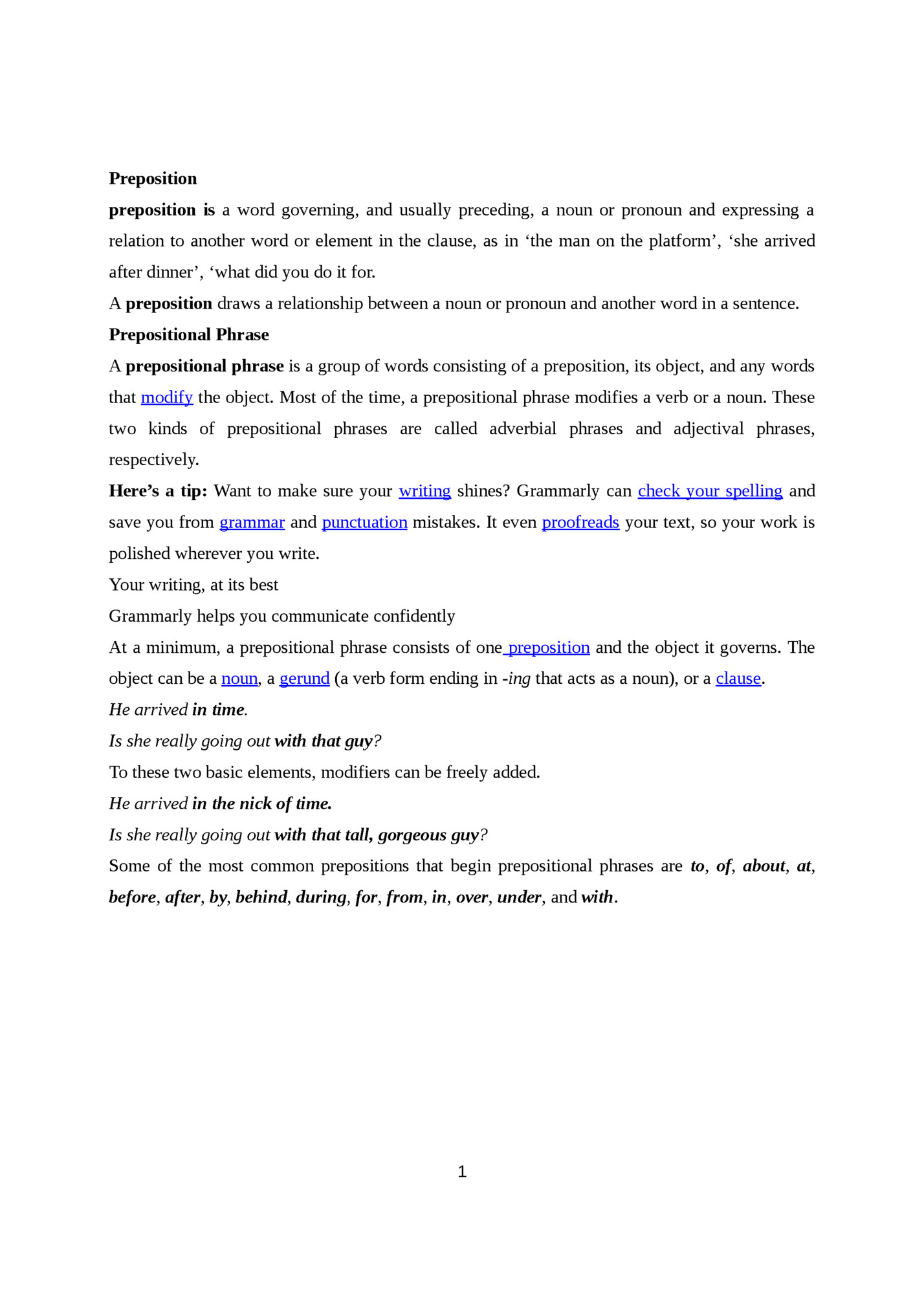
When a prepositional phrase acts upon a noun, we say it is behaving adjectivally because adjectives modify nouns. A prepositional phrase that behaves adjectivally is called, quite logically, an adjectival phrase. The cat in the middle is the cutest. I always buy my milk from the convenience store on Main Street. My mother has always wanted to live in a cabin by the lake. In the first of these sentences, in the middle answers the question of which cat the writer thinks is the cutest. Similarly, on Main Street gives us information about which store the writer is describing, and by the lake tells us what kind of cabin the writer’s mother is dreaming about. All of these adjectival phrases provide specificity to a noun in order to enhance our understanding. Prepositional phrases that modify verbs When a prepositional phrase acts upon a verb, we say it is behaving adverbially because adverbs modify verbs. A prepositional phrase that behaves adverbially is called an adverbial phrase. To find the person who stole the last cookie, look behind you. Harry drank his butterbeer with fervor. In the first sentence, behind you answers the question “Look where?” In the second, with fervor answers the question “Drank how?” Prepositional phrases acting as nouns Less frequently, prepositional phrases can function like nouns in a sentence. During the national anthem is the worst time to blow your nose. After the game will be too late for us to go to dinner. How to avoid excessive prepositional phrases It is tempting to overuse prepositions and prepositional phrases. If you see more than one preposition for every ten or fifteen words in your writing, you should edit some of them out. You may be surprised at how much more elegant and economical your writing is when you make the effort to do this. It is best to behave with caution when running with a sword in the presence of Magneto. There is nothing grammatically incorrect about the above sentence, but it has two with phrases, an of phrase, and an in phrase, which is a sure sign that it could be written more efficiently. In Magneto’s presence, run cautiously with swords. 2
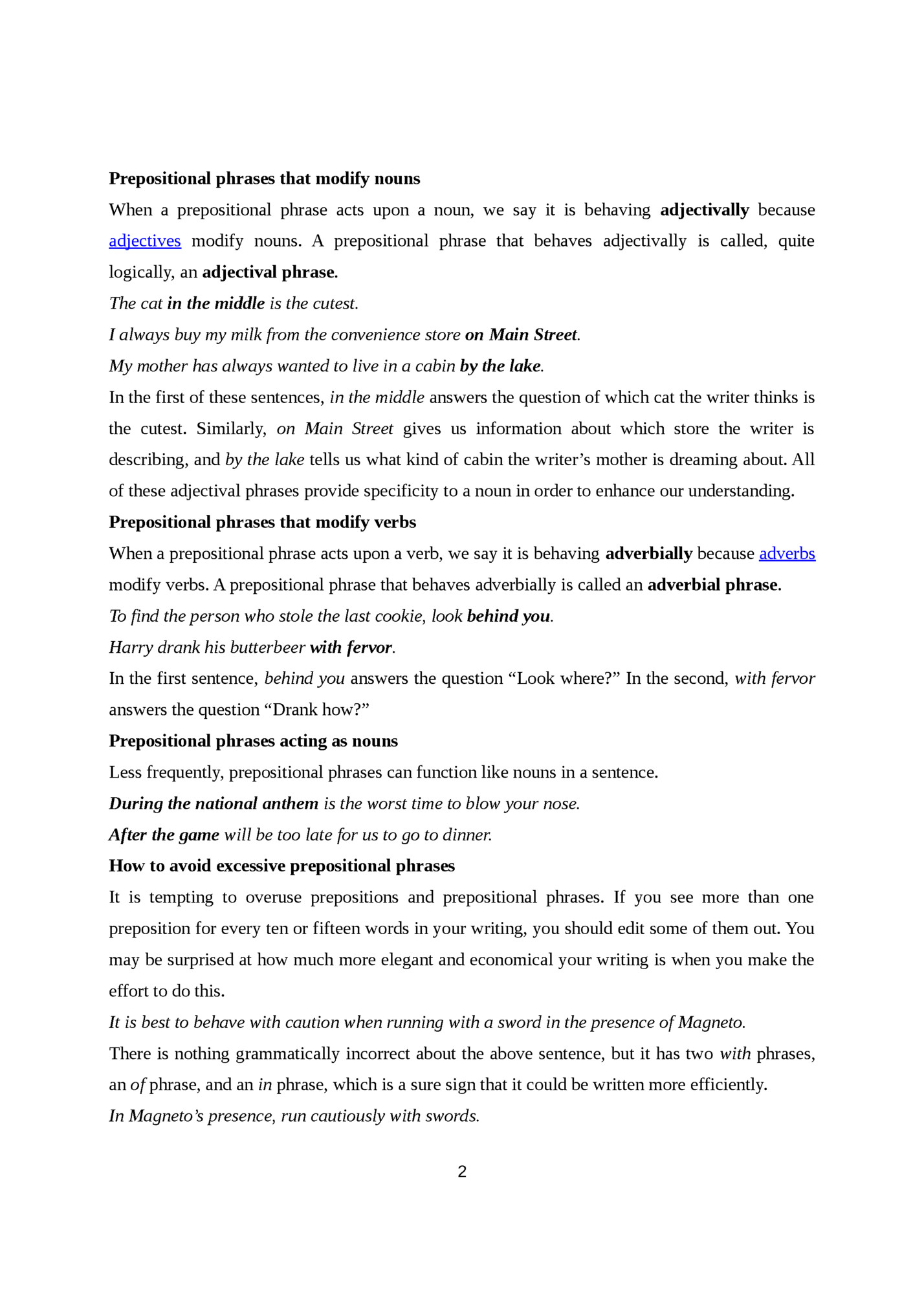
correlating adverb cautiously. Of Magneto was simply a possessive that could be easily converted to Magneto’s. Four prepositional phrases have been reduced to two. Another way to reduce prepositional phrases is to switch from a passive voice to an active voice. There is a famous example to illustrate this concept. Why was the road crossed by the chicken? Clearly, the passive voice makes this sentence fussy, and the prepositional phrase by the chicken seems a bit silly. It would be better written in an active voice, with the chicken in the driver’s seat, where it belongs. Why did the chicken cross the road? 2) Conjunction Conjunctions, in grammar, are a type of part of speech that connects the words or phrases or clauses. In the absence of conjunctions, we are forced to express complex sentences by breaking them into short simple sentences. These conjunctions are used wisely to convey the same meaning. The conjunctions can either be in the format of a single word or compound or correlative. It can appear at the beginning of a sentence or in the middle of a sentence but it depends on the type of conjunction being used. Example: She bought a flower and chocolates from the market. Types of Conjunction and Examples There are three different types of conjunctions: 1. Coordinating Conjunctions: Coordinating conjunction definition is as follows, the conjunction that joins two elements that have equal syntactic importance and grammatical rank. They can join two independent clauses, two phrases, two adjectives, two verbs or two nouns. There are seven coordinating conjunctions, they are - for, and, nor, but, or, yet, and so. The easiest way to remember these conjunctions is with an acronym called FANBOYS. Among all these conjunctions “so” can be used both as coordinating and subordinating conjunctions. As coordinating conjunction, it can link two independent clauses and as subordinate conjunction, it can link two unequal clauses. 3
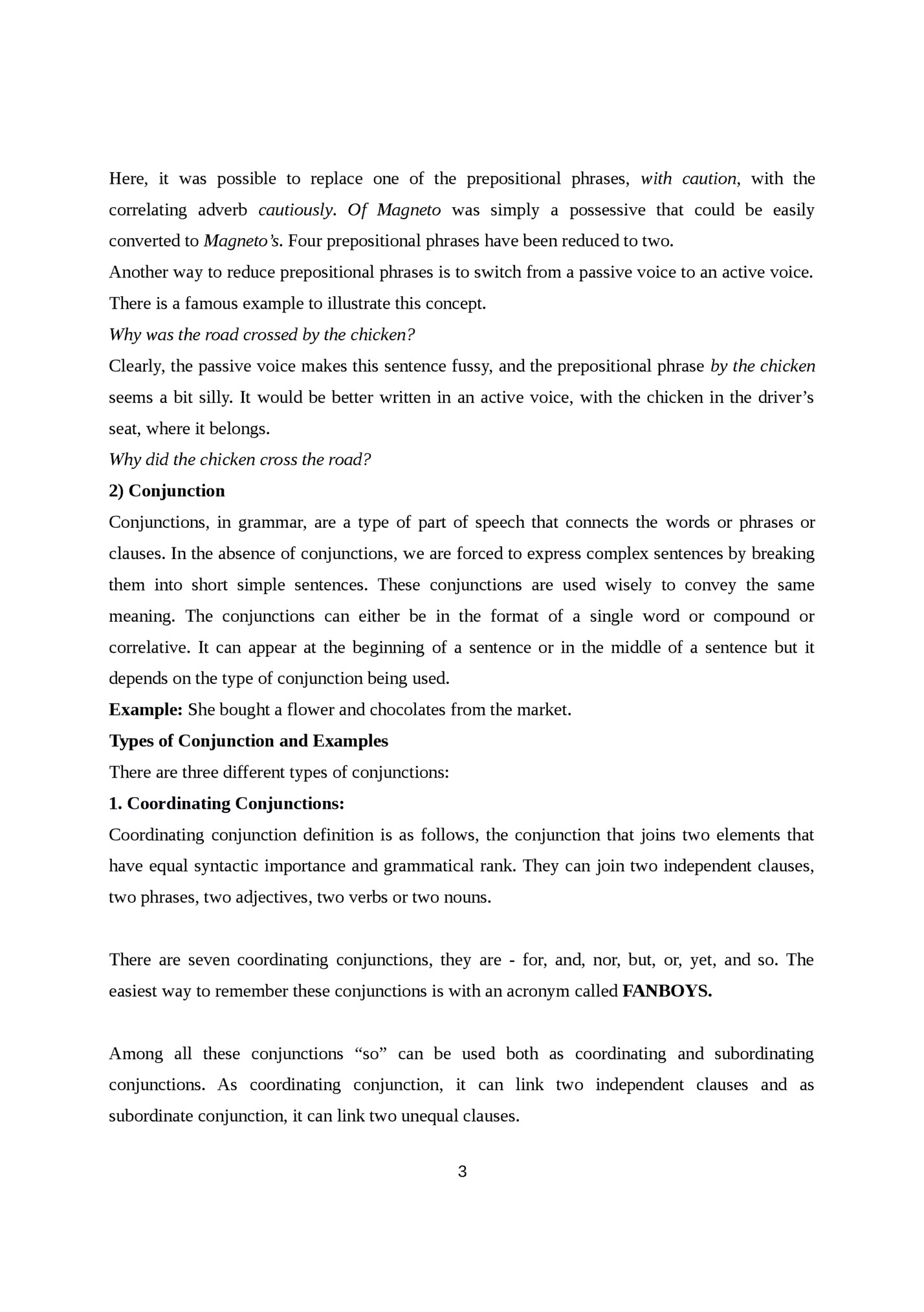
There are a few rules which have to be followed during the use of suitable conjunctions along with the usage of words in specific situations: • When the coordinating conjunction connects two independent clauses, a comma has to be used before that conjunction. Example: I wanted to go shopping, but my friend wants to go to a movie. • When coordinating conjunction is joining two phrases or words, a comma is not used before the conjunction. Example: I like to ride bikes and swim. • A comma is optional when coordinating conjunction is used with more than two items. 2. Correlative Conjunctions: These are a kind of tag-team conjunctions. They come in pairs where they are used in different places. Correlative Conjunction Examples: either/or, neither/nor, not only/but also, whether/or, not/but. • I either want a chocolate cake or pastry. • She neither likes tea nor coffee. 3. Subordinating Conjunctions: The subordinating conjunction meaning and examples are provided here. These are the types of conjunctions that help to join dependent clauses with independent clauses. Some of the common subordinating conjunctions are “since, because, though, as, although, while, and whereas”. Sometimes the adverbs can also act as conjunctions such as, “until, after, or before”. Example: I can stay here until the clock strikes nine. Here the word “until” acts as a conjunction that connects two ideas such as, “can stay here” and “clock strikes nine”. Here the first idea is independent of the second one hence, “can stay here” is an independent clause, and “clock strikes nine” is a dependent clause. It is not mandatory to have the subordinating conjunctions in the middle of the sentence, but it has to be a part of the dependent clause. The dependent clause is also called the subordinate clause or subordinating sentences. The dependent clause has two specific qualities, 4
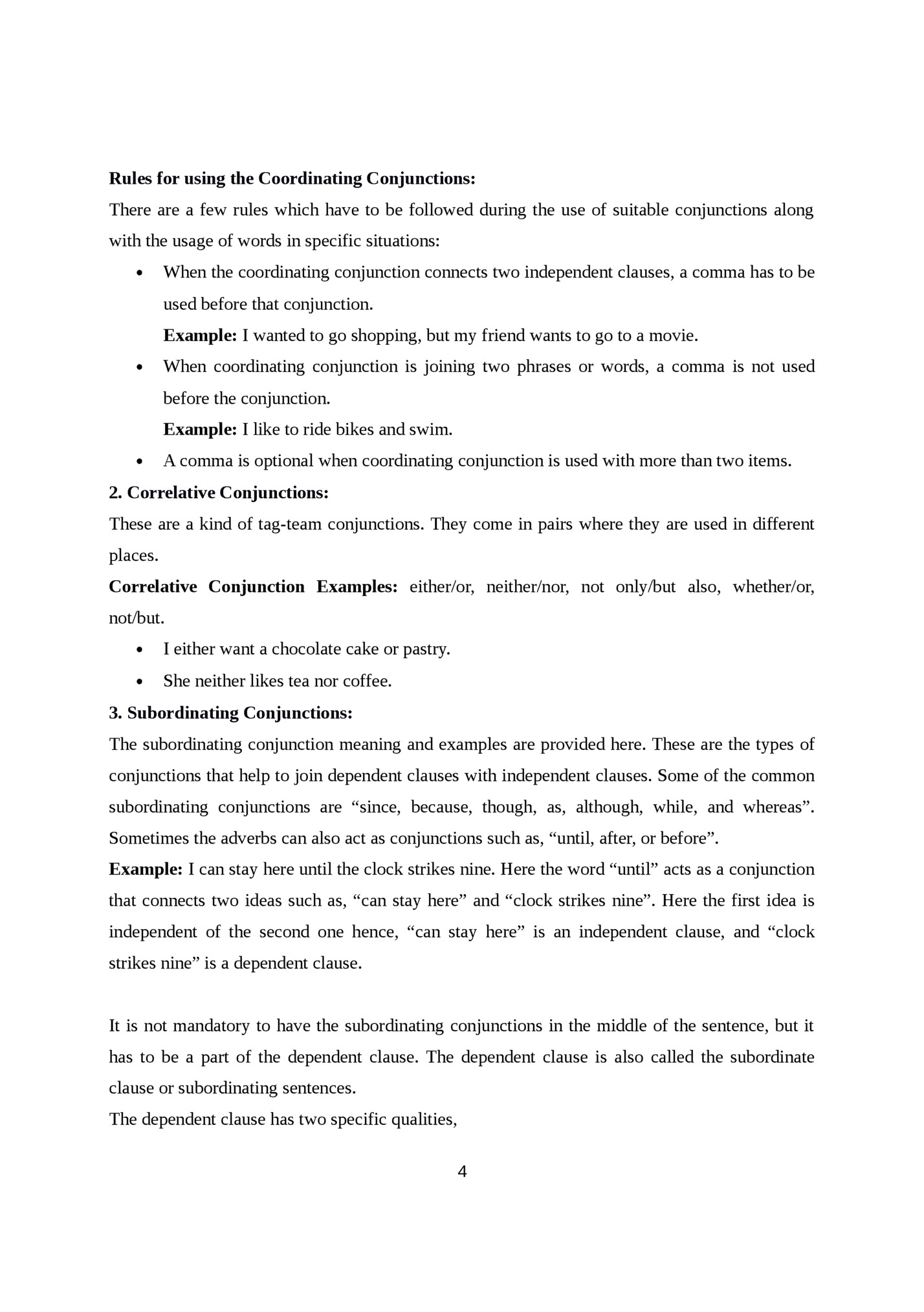
It cannot act as it’s a sentence. • It depends on the independent clause to provide a complete meaning. Types of Subordinating Conjunctions The subordinating conjunctions are categorized by meaning: 1. Time: When the main clause is performed or will be performed, the time-related conjunctions establish a period. Example: as soon as, once, before, still, whenever. I will clean the house after the relatives are gone. 2. Concession: By providing the additional information the concession conjunctions help to redefine the meaning of the main clause. It highlights the action that has happened in the hindrance or obstacle. Example: although, even though, as though. She wrote my article even though it is assigned to me. 3. Comparison: It helps to establish the connection between the words by providing a correlation. Example: though, whereas, just as, in contrast to. You will complete the work fastly whereas I need some more time. 4. Cause: It defines the reason the main clause was performed. Example: because, since, so that. My father always inspires me because he believes in me. 5. Condition: It provides the rules under which the main clause works. Example: If, in case, even if, unless. In case my sister suggests buying this dress, then I will go for it. 6. Place: It defines the place where the action or the activities occur. Example: wherever, whereas. I will place the conjunctions wherever it is necessary. Conclusion Here, we have seen the conjunction definition and examples, we can conclude that conjunctions help us to combine the simpler sentences to make a single complex sentence. We should be very careful while placing the comma and see to it that the appropriate conjunctions are used. The 5
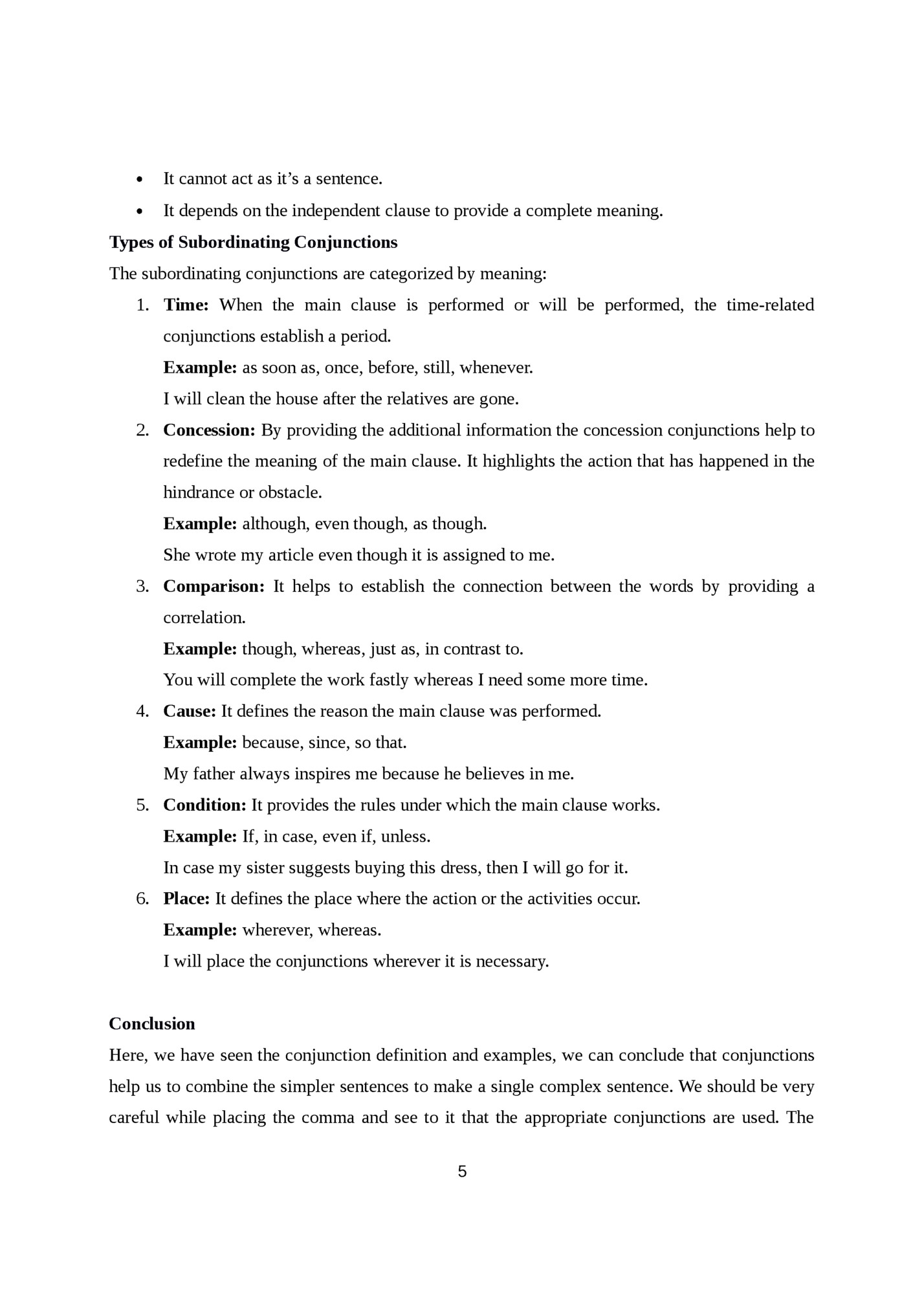
If the subordinate clause appears at the starting of the sentence, then the whole sentence is followed by a comma. 3) Direct and indirect speech exercises There are many occasions in which we need to describe an event or action that happened, and very often that includes repeating what someone said. Such occasions can include a social situation as well as in a work email or presentation. In order to describe what people said there are two different types of speech – direct speech and indirect speech (or reported speech). Direct Speech When we want to describe what someone said, one option is to use direct speech. We use direct speech when we simply repeat what someone says, putting the phrase between speech marks: • Paul came in and said, “I’m really hungry.” It is very common to see direct speech used in books or in a newspaper article. For example: • The local MP said, “We plan to make this city a safer place for everyone.” As you can see, with direct speech it is common to use the verb ‘to say’ (‘said’ in the past). But you can also find other verbs used to indicate direct speech such as ‘ask’, ‘reply’, and ‘shout’. For example: • When Mrs Diaz opened the door, I asked, “Have you seen Lee?” • She replied, “No, I haven’t seen him since lunchtime.” • The boss was angry and shouted, “Why isn’t he here? He hasn’t finished that report yet!” Indirect Speech When we want to report what someone said without speech marks and without necessarily using exactly the same words, we can use indirect speech (also called reported speech). For example: • Direct speech: “We’re quite cold in here.” • Indirect speech: They say (that) they’re cold. When we report what someone says in the present simple, as in the above sentence, we normally don’t change the tense, we simply change the subject. However, when we report things in the past, we usually change the tense by moving it one step back. For example, in the following sentence the present simple becomes the past simple in indirect speech: • Direct speech: “I have a new car.” 6

Indirect speech: He said he had a new car. All the other tenses follow a similar change in indirect speech. Here is an example for all the main tenses: The same rule of moving the tenses one step back also applies to modal verbs. For example: 7

As an alternative to using ‘say’ we can also use ‘tell’ (‘told’ in the past) in reported speech, but in this case you need to add the object pronoun. For example: • He told me he was going to call Alan. • They told her they would arrive a little late. • You told us you’d already finished the order. Changing Time Expressions Sometimes it’s necessary to change the time expressions when you report speech, especially when you are speaking about the past and the time reference no longer applies. For example: • Direct speech: “I’m seeing my brother tomorrow.” • Indirect speech: She said she was seeing her brother the following day. Here are some other examples: • Direct speech: “I had a headache yesterday.” • Indirect speech: You said you’d had a headache the day before yesterday. • Direct speech: “It’s been raining since this afternoon.” • Indirect speech: He said it’d been raining since that afternoon. • Direct speech: “I haven’t seen them since last week.” • Indirect speech: She said she hadn’t seen them since the previous week. Reporting Questions When you report a question, you need to change the interrogative form into an affirmative sentence, putting the verb tense one step back, as with normal reported speech. 8
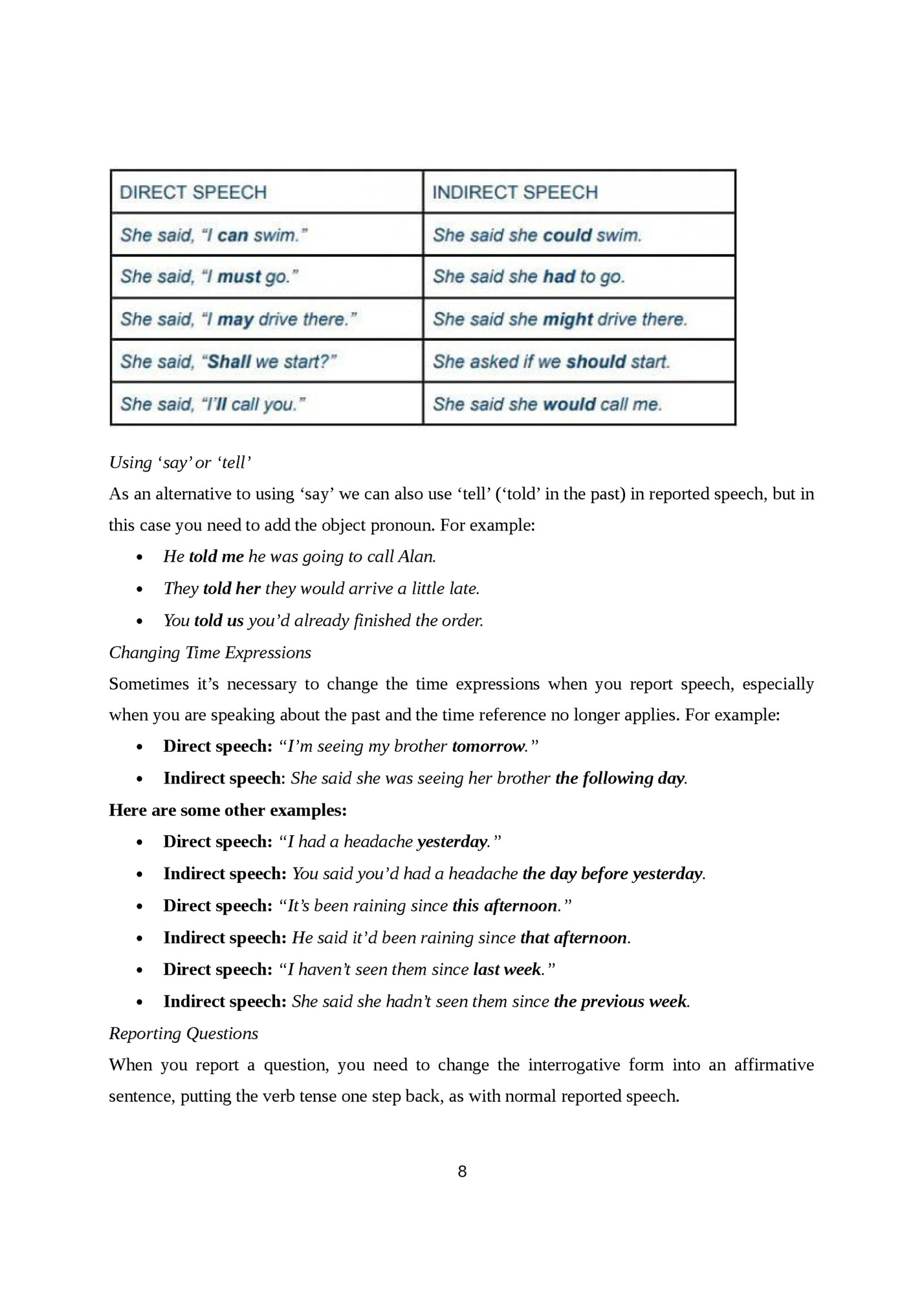
questions that begin with a question word like ‘what’, ‘where’, ‘who’ etc. When we report a yes/no question, we use ‘if’. For example: • Direct speech: “Do they live here?” • Indirect speech: You asked me if they lived here. As you can see, in the reported version of the question, ‘do’ is eliminated because it is no longer a question, and the verb ‘live’ becomes ‘lived’. For questions starting with question words like ‘what’, ‘where’, ‘when’, ‘who’, etc., we report the question using the question word but change the interrogative form to the affirmative form. For example: • Direct speech: “Where do they live?” • Indirect speech: You asked me where they lived. • Direct speech: “When are you leaving?” • Indirect speech: He asked us when we were leaving. • Direct speech: “How will they get here?” • Indirect speech: She asked me how they would get here. When we report a question, we normally use the verb ‘ask’. As with the verb ‘to tell’, the verb ‘to ask’ is normally followed by an object pronoun, though it is possible to omit it. Reporting Orders and Requests When you give someone an order, you use the imperative form, which means using just the verb without a subject. For example: • “Call me back later.” • “Have a seat.” • “Don’t do that!” To report an order we use ‘tell’ and the infinitive of the verb. For example: • You told me to call you back later. • He told me to have a seat. • She told us not to do that. When you make a request, you normally use words like ‘can’, ‘could’, or ‘will’. For example: • “Could you call me back later?” • “Will you have a seat?” 9
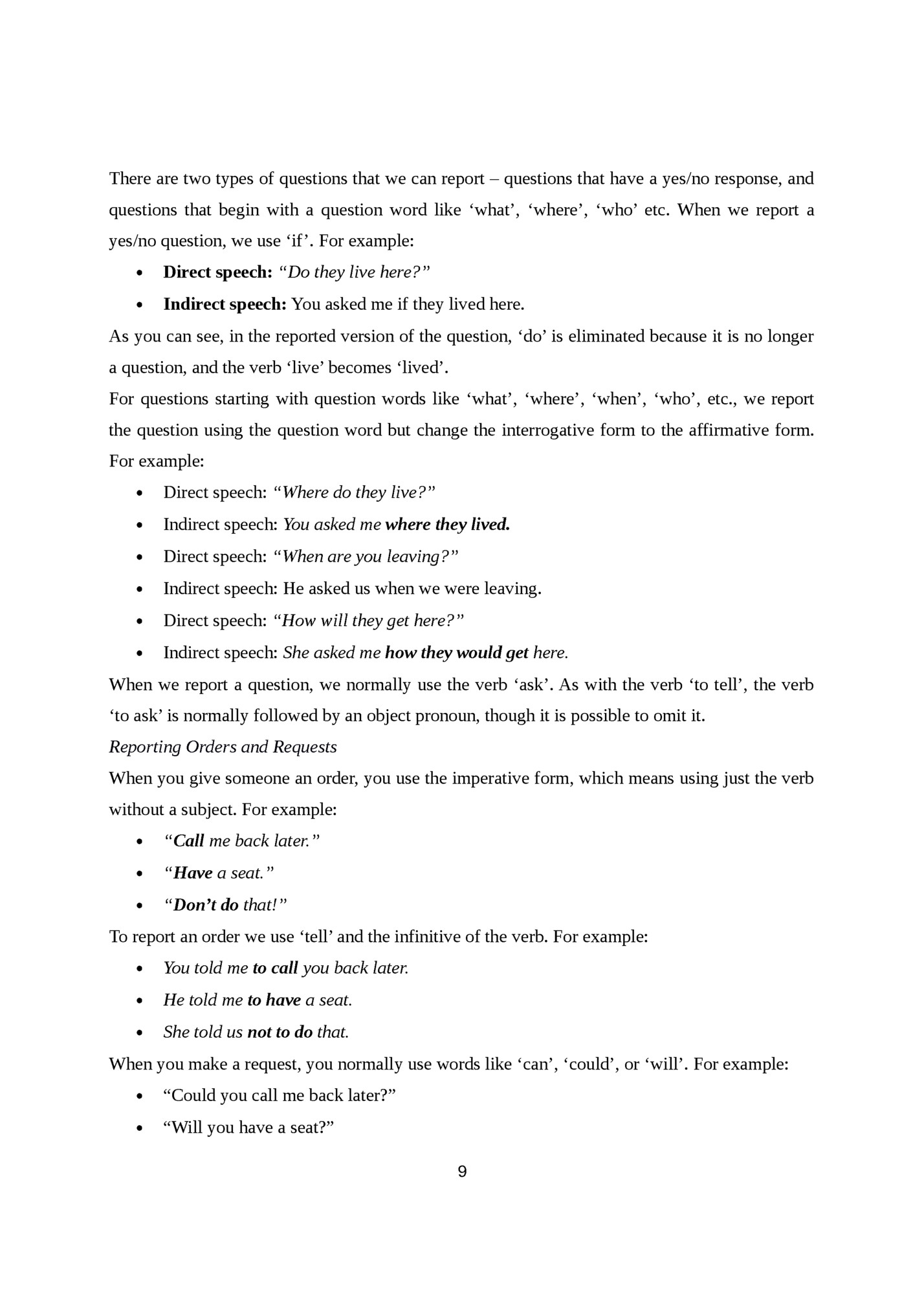
Fleepit Digital © 2021